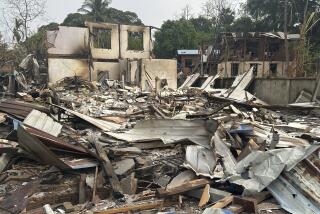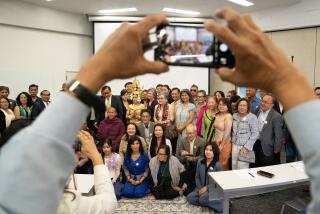Pol Pot Fanaticism Menacing Cambodia : Asia: U.N. officials say the terror tactics of his Khmer Rouge remain the biggest threat to peace.
PREY SBOY, Cambodia — Although he hasn’t seen his older brother in more than two decades, Saloth Ngeap remembers him as a hard-working and humble man who once studied to be a Buddhist monk.
And now? The 66-year-old, gray-haired rice farmer blinks furiously and stares down at the children and chickens playing around his sandal-shod feet in this dusty riverside hamlet in north-central Cambodia.
“My brother is a criminal,” he says angrily. “He kills many people.”
His sibling, Saloth Sar, is better known and feared by his nom de guerre , Pol Pot. As leader of the murderous Khmer Rouge, he ranks as one of the worst mass murderers of modern times. The Khmer guerrillas’ Maoist-inspired 1975-79 reign of terror left more than a million people dead and a devastated country.
And today, as the largest and most expensive United Nations peacekeeping operation in history strives to bring peace and democratic elections to a land ravaged by 22 years of conflict, Pol Pot’s bloody fanaticism continues to cast a long, dark shadow over Cambodia’s future.
Artillery duels and rocket fire can be heard almost daily here in Pol Pot’s home village, two miles from the provincial seat in Kompong Thom. Farther north, past deadly minefields and dynamited bridges, a steady supply of Khmer Rouge ammunition, rocket-propelled grenades, mortars and machine guns are carried on bicycles, oxcarts and trucks down a dusty track that crosses northern Cambodia.
In a reminder of their savage style, two dozen Khmer Rouge fighters in green uniforms massacred 14 ethnic Vietnamese civilians with AK-47 rifles and grenades after dark on Dec. 27 in Kompong Taches, a tiny fishing village along the murky brown Tonle Sap River.
Still-terrified survivors say one woman, Le Thy Yong, begged over and over for mercy when three Khmer Rouge found her clutching her 9-month-old son to her breast and a 3-year-old boy hiding in reeds by the river. The guerrillas shot the woman in the face, blasted another man nearby and fired a burst into the young boy’s head and stomach as he cried in the mud. The 9-month-old was wounded in the leg but survived.
“I’ve never seen cruelty like that,” Sou Sakhan, a 43-year-old fisherman who later rescued the infant, said emotionally as he pointed out the site of the riverside slaughter. “They just shoot without reason. No reason. Even the children.”
U.N. officials and diplomats say the Khmer Rouge terror tactics, six months after the guerrillas reneged on the 1991 Paris peace agreement with three other factions to disarm and demobilize, remains the biggest threat to a peaceful Cambodia. Officials estimate that the Khmer Rouge has about 12,000 guerrillas.
The rebels refused to allow U.N. election teams in their areas and ignored a Jan. 27 deadline for registering their party for national elections for a constituent assembly. With more than 90% of eligible voters now registered, voting for the new government--with or without the Khmer Rouge--is scheduled for May 23-25.
“What will the Khmer Rouge do?” asked a senior Western diplomat in Phnom Penh, the capital. “Will they lob shells at every polling place? Will they intimidate people going to vote? We don’t know. That’s the problem.”
Other problems are more immediate, another longtime Western observer warned. “Pol Pot must be laughing,” he said. “In his view, things are going his way at the moment.”
The Vietnamese-backed Communist government of Premier Hun Sen remains widely unpopular. It is blamed for increasing political violence, widespread corruption and common banditry.
“People are very angry at the government,” said Khieu Thy, a 30-year-old former soldier in Siem Reap, near the famed temples of Angkor. “They say at least the Khmer Rouge are not corrupt.”
Despite its many good deeds, the 22,000-member U.N. peacekeeping force, like the government, is far from universally popular in this desperately poor country.
U.N. officials, paid salaries plus $145 a day as a hardship allowance, crowd Phnom Penh’s tony La Mousson Restaurant, which serves caviar on blinis. Air-conditioned U.N. offices close for a two-hour lunch break each day while thousands of Cambodian employees--including mine-clearing teams earning $1.50 a day--have not been paid in weeks.
Most worrisome of all, Khmer Rouge troops have stepped up artillery attacks and small-scale ambushes against government troops in four provinces of northern and western Cambodia. Government troops have launched their own offensive against the Khmer Rouge in recent days and were reported moving closer to their headquarters in Pailin, in western Cambodia.
No U.N. troops have been killed. But Khmer Rouge guerrillas have repeatedly seized and detained U.N. peacekeepers in the last two months. They also fired 75 Chinese-made 107-millimeter rockets at a U.N. compound of Bangladeshi infantrymen in Svea Leu on Dec. 31. It was apparently the first time U.N. troops were deliberately targeted by the Khmer Rouge.
Yasushi Akashi, head of the U.N. peacekeeping force in Cambodia, warned at a press conference last month that the military situation “may worsen before it improves” in the current dry season. He said he is “very concerned that a neutral political environment does not exist” but insisted that voting will take place as planned.
Lt. Gen. John Sanderson, the U.N. military commander, says the Khmer Rouge is incapable of a major offensive. Instead, he says the guerrillas are consolidating their territory, now nearly 20% of the Missouri-sized country.
“I see all these incidents as an attempt (by the Khmer Rouge) to control how we communicate and interface with their people,” said Sanderson, an Australian. “ ‘You do not go into these areas without our agreement.’ That’s what they’re saying.”
The Khmer Rouge insist that Vietnamese troops, historical enemies of the Khmer Rouge who invaded and forced them from power in 1979, are still in Cambodia. Sanderson says none have been found. And he dismisses the widespread fear that Pol Pot’s forces are biding their time until the departure of U.N. troops--now scheduled for August--to resume their brutal military campaign for control.
“They’ll never take over the government again,” he said. “Never! The Cambodian people will never allow it. I don’t think their neighbors will allow it. And I don’t think the international community would be very happy about it.”
But out in the field, the Khmer Rouge continues to bedevil the blue-bereted peacekeeping troops.
In Kompong Thom, for example, a two-star Khmer Rouge general named Men Rom worked for several months as local liaison with U.N. military observers. Last July 14, he disappeared from their blue-flagged office. That night, a barrage of 107-millimeter rockets slammed into town, exploding near the U.N. compound, the market and a major bridge.
“He had the exact coordinates of everything,” said Lt. Col. Eric Reizinger, an energetic Austrian who is the senior U.N. military observer in the area. Shells have landed regularly ever since.
Men Rom, it turned out, heads the Khmer Rouge’s crack 616 Division, based north of here in Sakim. U.N. officials know it well now: They helicoptered in to negotiate with the charismatic general for the release of U.N. hostages seized by the guerrillas. “He was mostly in charge of the kidnapings,” Reizinger said.
By all accounts, Men Rom’s direct superior is Ta Mok, an infamous one-legged commander known as “The Butcher” for his role in the murderous purges that characterized the four-year Khmer Rouge regime. And Ta Mok, officials say, reports directly to Pol Pot.
The dusty scrub and dense jungle north of Kompong Thom, which sits astride a major road intersection, is the closest thing to a front in Cambodia. An estimated 3,000 hardened Khmer Rouge fighters are in nearby rice fields, rubber plantations and forests.
A visit to the zone with a four-person U.N. observer patrol led by Maj. Sergei Dounkov, a thick-muscled Russian, required first crossing a bridge recently rocketed and mined by the Khmer Rouge. Steel I-beams were twisted like pipe cleaners.
“Pol Pot did this,” said a farmer, peering at the wreckage from his bicycle.
A few miles up the rutted dirt road in Sala Visay, Maj. Richard Hutadjulu, a U.N. observer from Indonesia, offered coffee and advice in his sandbagged office. Khmer Rouge and Cambodian troops have both mined roadsides and nearby fields, he warned.
“All the red is mines,” he said, jabbing with a pointer at red splotches on his wall maps. “Mines are everywhere. Mines, mines, mines. Go off the road, left or right, you’ll definitely hit a mine.”
Under another tent, two soldiers listen intently to a blaring radio tuned to Democratic Kampuchea, the Khmer Rouge’s station. U.N. officials have complained, so far in vain, over the increasing venom of the radio propaganda.
One recent broadcast accused U.N. officials of running “Vietnamese brothels.” Another, according to a U.N. transcript, complained that the United Nations “has allowed the Vietnamese invaders and Phnom Penh puppets to cruelly and barbarously bully, plunder and murder the Cambodian people, oppress other political parties, unleash terrorism and create insecurity nationwide.”
A cool breeze caresses the mine fields as the patrol drives back. The white U.N. car speeds through a village swelled with refugees from the fighting, and small children run out laughing and waving. Dounkov waves back.
“It’s such a shame,” he said softly. “All the land is fertile. The rivers have fish. There are trees, there is vegetation, there is rain. Give the Cambodians a few years of peace, and they’ve got everything.”
More to Read
Sign up for Essential California
The most important California stories and recommendations in your inbox every morning.
You may occasionally receive promotional content from the Los Angeles Times.











